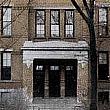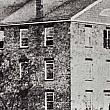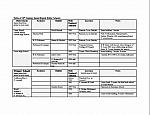
New Central High School and Primary Schools
by Diana Barrett
In May of 1891 the School Board’s Committee on Buildings recommended that a new high school be erected on the grounds of the current building, and to be ready for occupancy in September of 1892. They further recommended that the current building, constructed in 1868, be retained as a grammar school.[1]
The following month the committee submitted a plan as well as a pencil sketch of the Ransom St. elevation. Space would be provided on first floor for a manual training dept., recitation rooms were conveniently situated near classrooms, and on the upper floor room for the Kent Scientific Institute collection. Should the building become inadequate in future years, additions could be made without detriment to the symmetry of the proposed building. Careful attention was given to sanitation, but it was not adequate (we are not told if this was the fault of the architect or the builders, but it is likely both were culpable). Estimated cost, $54,500.[2]
In August the committee employed local architect, William G. Robinson, to prepare working plans and specifications, in duplicate. Robinson was to receive as commission 2% of the building cost at $50,000; 1¾ % if cost was between $50,000 & $60,000; and 1½ % if cost exceeded sixty thousand.[3]
In December 1891, the building Committee received ten general sealed proposals and several for special parts of the work for completing the new High School building. Messrs. Hauser, Hayden & Co submitted the lowest figures for the three possible combinations of building materials requested by the committee:
1. Cream brick with pine finish: bid $62,009
2. Cream brick with red-oak finish: bid $63,550
3. Red brick facing, red oak finish: bid $69,140
The committee was unanimous in recommending the use of red brick facing w/red oak finish. The building was to be completed by Sept 1, 1892.[4]
Romanesque Revival Style
The design of the school, commercial Romanesque-revival style, displayed general massiveness in both the building and in its heavy details. It differed from true Romanesque, or even Romanesque Revival, in that it was built largely of brick (Romanesque and its revival is more typically built of rusticated stone, and more rarely, smooth cut stone, but brick was cheaper).
The banding in the walls, marking the floor levels may hint of a greater consciousness of the structural aspects of the building in the mind of the architect. The large, slightly elliptical arch (as opposed to a round, true arch) in the upper end of the building was a bit unusual, but probably was necessary to fit within the design. This sort of element, which would have been structural and not merely decorative in an original Romanesque structure, is very typical of the style.
The decorative ends of the arches, called bosses, are reminiscent of medieval structural elements, and were used with wild, decorative success by both H. H. Richardson and later, by Louis Sullivan.[5]
Additional Primary Schools
At the same board meeting the Building Committee was authorized to procure necessary plans and specifications for the construction of eight-room buildings for the 1st, 5th, 6th, 8th, and in the south end of the city in the 10th ward, as well as plans and specifications for the improvement of the Wealthy Ave. School, and an addition there of 4 rooms. [6]
During this time, as never before, the Board of Education faced constant challenges to provide schools for the burgeoning population. This was compounded in 1891—as the board was making plans for a new Central School—when the city enlarged its boundaries by about nine square miles, creating a pressing need for new schoolhouses in some of the annexed territory, mostly in the eastern and southern portions of the city.
In addition, the board had built several primary schools prior to the annexation, and was also paying rent for additional space to augment several other primary schools: two rooms at the Grandville Ave. annex, four rooms on Hall St., three more on S. Division St., two rooms on Lyon St., a rented annex for Pine St., and expected to need two rented rooms on W. Leonard St. This burden of space requirements, particularly for primary schools, was cited as the reason for delaying the establishment of kindergartens, which had been in the Board’s plans for quite some time. By the turn of the century the city boasted 35 elementary schools, two high schools, and a grammar school.[7] More than three times the number of buildings that existed only thirty years earlier.
As the close of the 19th century approached, the School Board was exhausted, and financially tapped out. At least 21 additions to schools had been built since 1871, 21 new schools constructed (including two large high schools), 7 schools acquired through annexation in 1891, but only two, Congress and Diamond, were comparable to Grand Rapids schools. In 1896 the School Board announced, “Much needed repairs [to school buildings] would be omitted due to lack of funds.”
[1] Bd. of Ed. Minutes, 5/2/1891, p 748
[2] Bd. of Ed. Minutes, 6/6/1891, p 764,
[3] Bd. of Ed. Minutes, 8/11/1891, p 786
[4] Bd. of Ed. Minutes, 1/23/1892, p 39-40
[5] Note: Romanesque-revival description and comments contributed by Thomas R. Dilley
[6] Bd. of Ed. Minutes, 1/ 23/1892, p 41-42
[7] Bd. of Ed. Minutes, 8/1/1891, p 780

 facebook
facebook














